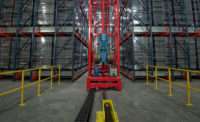U.S. consumers continue to lean toward snacking. According to the 2017 “State of the Snack Food Industry” report from IRI, Chicago:
- More people are snacking five or more times per day
- Salty snacks, as well as bakery products like granola bars and cookies, all grew in both dollars and units over the past year
- Sales of indulgent snacks are picking up
Meanwhile, the desire for progressively improved margins remains a common theme in the business of snacking. Also, the need for ever-safer operations will continue. In order to learn more about how snack producers and bakeries are helping streamline production along these lines, we recently spoke with Tom Egan, vice president, industry services, PMMI, The Association for Packaging and Processing Technologies, Reston, VA, to learn about how automation and robotics are helping snack producers and bakers keep up with changing demands.
Douglas J. Peckenpaugh: How is robotic automation helping food producers better manage labor resources?
Tom Egan: Before I delve into the solutions, it probably helps to look at the current environment for consumer packaged goods (CPG) producers in the snack food category. What are the drivers that are impacting the snack food industry overall today? PMMI’s 2017 “Trends in Food Processing Operations” report finds that we are seeing two main drivers when it comes to snack foods. One is a consumer drive, especially amongst millennials, for alternative snacking solutions. And, as a result, we have a proliferation of SKUs as the CPG manufacturers offer more product choices.
This also leads to multiple sizes that are required for different snacking opportunities throughout the day. As an example, I was recently at the store and noticed these large 14-ounce bags of a product called Simply Popcorn. It measures about 20 inches long. Right next to it was a pallet with a box of 36 of the half-ounce bags of the Pirate’s Booty popcorn. Now, talk about a difference in products! One is a secondary package with 36 half-ounce bags inside aimed at individual snacking occasions, and the other is a single 14-ounce large bag of popcorn designed to be used when a group of friends get together, for example. But both of these packages are going to run through a similar facility since they’re both popcorn. The automation that you need to help that project be successful and to operate as quickly and efficiently as possible may, in fact, involve robots. So, there’s a need for a very adaptable robot in order to help produce what is truly a very wide range SKUs.
Automation and robotics can help manufacturers keep up with the need for more frequent changeovers, the need to handle the wider number of SKUs, and the broader size range of the physical SKU products.
Now expand this to the trends impacting the workforce today. Companies today face multiple workforce challenges, including: what is the necessary training and how to find new workers. Some food producers take the approach to involve more automation including robots. You may now need one individual to oversee a more automated line and possibly place other workers in higher-level positions.
DJP: What are some examples of recent automation advances that will help drive this segment of the industry forward?
TE: The automation advances that I see are for those different sizes. Now you’re looking at more sophisticated end-of-arm tooling. These are the devices that are at the end of the robot arm, utilized to safely pick up a variety of products whether you’re going to work with placing two bigger bags directly for shipment or putting 36, in the case of the half-ounce bags, into a shipper.
DJP: How can automated ingredient handling help decrease the level of dust in a food facility, along with the associated safety risks?
TE: Automation enables you to work with larger bulk packaging instead of smaller package sizes, so as a result there is less handling of the product needed in the overall operation. You can use larger bags because you are not necessarily limiting yourself to a manual operation now. So the opportunity is there to reduce the dust that comes from handling, for example, five totes, with quite a bit more product in them instead of 25 smaller bags. So, I’m making fewer numbers of transfers in order to handle the same amount of product, for example flour, into whatever ingredient mix I’m doing.
Also, as automation improves it enables you to feed in the ingredients in a more precise and regular manner. Instead of putting it into batch, I can now handle it with automation to meter the ingredient on a much more regular basis and therefore it’s a more closed-loop system that does not even allow dust into the environment.
DJP: What are some other recent examples of equipment improvements that contribute to a safer work environment in food manufacturing facilities?
TE: We are seeing continual, incremental improvements. It doesn’t always mean a huge breakthrough, an “a-ha! moment.” Rather, smaller improvements mean machines operate better and that results in less of a need for operator interaction. This is increasingly allowing for the operator to act as more of an observer of the process and only have to introduce themselves in those less frequent instances when an issue arises.
Also, the machines can now identify potential problem areas more quickly and more specifically than they could before. For example, a warning light in the area where a jam has occurred pinpoints the problem location, so the operator doesn’t have to search along the entire length of the machine.
Not only do you reduce the number of interactions the operator has to have with the machine, but the overall process is safer for the operator, and the process is more efficient because the machine is operating more continuously.
The almost 6,500 visitors to this year’s inaugural ProFood Tech, held April 4-6 in Chicago, were able to experience the way automation and robotics are revolutionizing the snack food industry firsthand. The event featured the latest technology from some 447 national and international exhibitors from 16 countries. Registration is now open for the largest-ever PACK EXPO Las Vegas and the co-located Healthcare Packaging EXPO (Sept. 25–27; Las Vegas Convention Center). PACK EXPO Las Vegas—produced by PMMI, The Association for Packaging and Processing Technologies—will bring together top CPGs from around the world to explore state-of-the-art packaging technologies, equipment and materials as well as exchange ideas with peers and build professional relationships.
This high-quality event convenes the biggest gathering in North America of suppliers and manufacturers of goods, including pharmaceuticals and medical devices, in a powerful way that drives innovation. Registration, which includes access to both PACK EXPO Las Vegas and Healthcare Packaging EXPO, is $30 until Sept. 1 when the price increases to $100.
About PMMI
PMMI, The Association for Packaging and Processing Technologies, represents the voice of more than 750 North American manufacturers and suppliers of equipment, components and materials as well as providers of related equipment and services to the packaging and processing industry. We work to advance a variety of industries by connecting consumer goods companies with manufacturing solutions through the world-class PACK EXPO portfolio of trade shows, leading trade media and a wide range of resources to empower our members. The PACK EXPO trade shows unite the world of processing and packaging to advance the industries they serve: PACK EXPO International, PACK EXPO Las Vegas, Pharma EXPO, PACK EXPO East, EXPO PACK México, EXPO PACK Guadalajara and ProFood Tech, launching in April 2017. PMMI Media Group connects manufacturers to the latest solutions, trends and innovations in processing and packaging year-round through brands including Packaging World, Automation World, Healthcare Packaging, Contract Packaging, ProFood World and Packaging + Processing OEM. PMMI Business Drivers assist members in pursuing operational excellence through workforce development initiatives, deliver actionable business intelligence on economic, market and industry trends to support members’ growth strategies, and actively connect the supply chain throughout the year.





